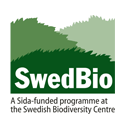Click on images to enlarge
/thumbs/opuntia_ficus-indica9_sml.jpg)
close-up of mature fruit (Photo: Sheldon Navie)
/thumbs/opuntia_ficus-indica7_sml.jpg)
flower and immature fruit (Photo: Sheldon Navie)
/thumbs/opuntia_ficus-indica6_sml.jpg)
habit (Photo: Sheldon Navie)
/thumbs/opuntia_ficus-indica4_-_FKS_sml.jpg)
close-up of the spines on a stem segment of the spiny form of this species (Photo: Forest and Kim Starr, USGS)
/thumbs/opuntia_ficus-indica3_sml.jpg)
spineless stem segments (Photo: Sheldon Navie)
/thumbs/opuntia_ficus-indica3_-_FKS_sml.jpg)
infestation of the spiny form of this species in Hawaii (Photo: Forest and Kim Starr, USGS)
/thumbs/opuntia_ficus-indica20_sml.jpg)
stem segments damaged by the prickly pear cochineal biocontrol agent (Photo: Sheldon Navie)
/thumbs/opuntia_ficus-indica1_-_SH_sml.jpg)
close-up of seeds (Photo: Steve Hurst at USDA PLANTS Database)
Scientific name
Opuntia ficus-indica (L.) Mill.
Synonyms
Cactus ficus-indica L.; Opuntia megacantha Salm-Dyck; Opuntia paraguayensis K. Schum.
Common names
Sweet prickly pear, Barbary fig, cactus pear, Indian fig, Indian fig prickly pear, Indian-fig, mission cactus, mission prickly pear, mission pricklypear, panini, prickly pear, prickly pear cactus, prickly-pear, pricklypear cactus, smooth mountain prickly pear, smooth prickly pear, spineless cactus, sweet pricklypear, tuberous prickly pear, tuna cactus.
Family
Cactaceae
Origin
The origin of this species is somewhat obscure, largely because it has been cultivated since ancient times for its edible fruit, but it is thought to have originated in Mexico.
Naturalised distribution (global)
Locations within which Opuntia ficus-indica is naturalised include Australia, southern Europe, Africa, La, southern Asia, southern USA and some oceanic islands with warm climates.
Introduced, naturalised or invasive in East Africa
Opuntia ficus-indica is invasive in parts of Kenya and Tanzania (A.B.R. Witt pers. obs. It is present in Uganda (A.B.R. Witt pers. obs.).
Habitat
Common in semi-arid rocky country and savanna.
Description
Opuntia ficus-indica is a succulent shrub or tree ranging 1.5-3 m but it can grow up to 5 m. It develops a sturdy trunk with age. The branches (cladodes) are flattened, grey to grey-green. The branches are 30-60 cm long and 6-15 cm wide. Its younger branches arch upwards.
The leaves of O. ficus-indica are minute and are shed early.
The flowers of O. ficus-indica are conspicuous, bright yellow or orange, red in colour. It bears succulent edible berries which are reddish when ripe, about 8 cm long and covered with clusters of minute spines.
Reproduction and dispersal
Reproduces vegetatively and through seed.
Similar species
Opuntia ficus-indica is very similar to Opuntia monacantha (drooping prickly pear) and Opuntia stricta (common prickly pear). These species can be distinguished by the following differences:
- O. monacantha is a relatively tall shrub or tree-like plant (usually 2-5 m tall) with flattened and elongated (oblong or obovate - egg-shaped in outline but with the narrower end at the base) cladodes. These cladodes are hairless and have one or two large spines on most of the areoles on their surfaces. It has yellow flowers and reddish-purple fruit, and some of its cladodes droop towards the ground during fruiting.
- O. ficus-indica is a relatively tall shrubby or tree-like plant (usually 1.5-3 m tall) with very large flattened and elongated (oblong, elliptic or obovate) cladodes. These cladodes are hairless and do not have any spines on the areoles on their surfaces. It has yellow flowers and reddish coloured fruit.
- O. stricta is a low-growing plant (usually 50-100 cm tall) with relatively large flattened and elongated (elliptic or obovate) cladodes. These cladodes are hairless and generally do not have any spines (sometimes one or two large spines are present) on the areoles on their surfaces. The flowers are bright yellow and the fruit reddish-purple.
Economic and other uses
Opuntia ficus-indica is cultivated as an ornamental or as live hedge. It can be used as a medicinal plant, and the fruit is edible. In some parts of Kenya, syrup is made from the fruit to consume in a variety of ways, such as use as a "mixer" in fancy cocktails served at tourist lodges.
Environmental and other impacts
Opuntia ficus-indica is considered a landscape transformer as it displaces indigenous species and dependent animals. The plant lowers the value of pastures since it cannot be browsed and it also impedes the movement of grazing animals. This species particularly threatens large scale cattle ranching in the arid and semi-arid lands.
O. ficus-indica has been included in the Global Invasive Species Database (GISD 2005). It has been listed as a noxious weed in South Africa (prohibited plants that must be controlled. They serve no economic purpose and possess characteristics that are harmful to humans, animals or the environment) and in most Australian states.
Management
The precise management measures adopted for any plant invasion will depend upon factors such as the terrain, the cost and availability of labour, the severity of the infestation and the presence of other invasive species. Some components of an integrated management approach are introduced below.
The best form of invasive species management is prevention. If prevention is no longer possible, it is best to treat the weed infestations when they are small to prevent them from establishing (early detection and rapid response). Controlling the weed before it seeds will reduce future problems. Control is generally best applied to the least infested areas before dense infestations are tackled. Consistent follow-up work is required for sustainable management.
Manual control can be effective when numbers of plants are very low but must be done carefully otherwise plant fragments will resprout into new plants, thus exacerbating the infestation. Both the spines and the glochids make this a difficult and uncomfortable process). Burning of uprooted plants will help minimise this risk if there is enough dry material to ensure that the material burns. Plants can be treated by herbicide stem injections. When using any herbicide always read the label first and follow all instructions and safety requirements. If in doubt consult an expert.
Controlled burns have been used to control Opuntia species. Such burns must be well-timed and coordinated to reduce the risk of creating a bushfire and there must be sufficient material to carry a hot fire. Fire could be used for small, isolate stands but it will not penetrate large stands.
The moth Cactoblastis cactorum feeds on this plant in its larval stages and can help control Opuntia ficus-indica as part of an integrated control programme. It was introduced to Tanzania but never established. It is likely that some cochineal species which feed on Opuntia species have been introduced to East Africa. This group offers some prospects for biological control of Opuntia species.
Legislation
Not listed as a noxious weed by the state or governments in Kenya, Tanzania and Uganda.
References
CABI Invasive Species Compendium online data sheet. Opuntia ficus-indica (prickly pear). CABI Publishing 2011. www.cabi.org/ISC. Accessed March 2011.
GISD (2005). Global Invasive Species Database online data sheet. Opuntia ficus-indica (interim profile). www.issg.org/database. Accessed March 2011.
Henderson, L. (2001). Alien weeds and invasive plants. A complete guide to declared weeds and invaders in South Africa. Plant Protection Research Institute Handbook No. 12, 300pp. PPR, ARC South Africa.
Henderson, L. (2002). Problem plants in Ngorongoro Conservation Area. Final Report to the NCAA.
Wikipedia contributors. "Opuntia ficus-indica." Wikipedia, The Free Encyclopedia. Accessed January 2011.
Editors
Agnes Lusweti, National Museums of Kenya; Emily Wabuyele, National Museums of Kenya, Paul Ssegawa, Makerere University; John Mauremootoo, BioNET-INTERNATIONAL Secretariat - UK.
Acknowledgments
This fact sheet is adapted from The Environmental Weeds of Australia by Sheldon Navie and Steve Adkins, Centre for Biological Information Technology, University of Queensland. We recognise the support from the National Museums of Kenya, Tropical Pesticides Research Institute (TPRI) - Tanzania and Makerere University, Uganda. This activity was undertaken as part of the BioNET-EAFRINET UVIMA Project (Taxonomy for Development in East Africa).
Contact
BioNET-EAFRINET Regional Coordinator: [email protected]












